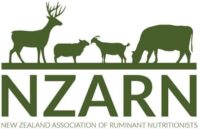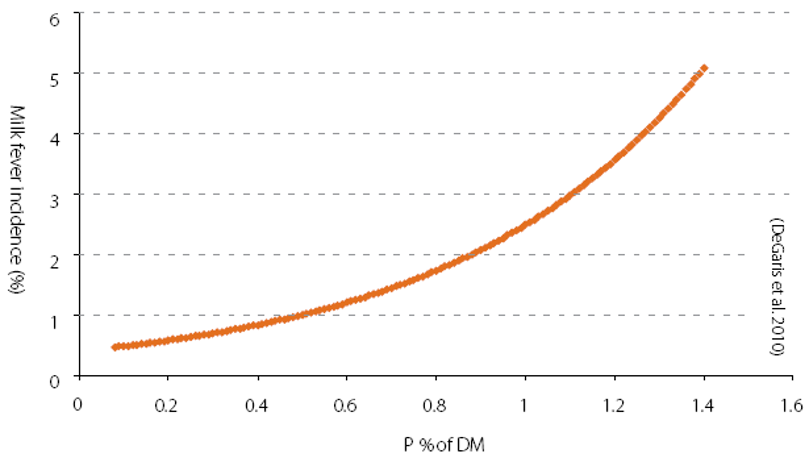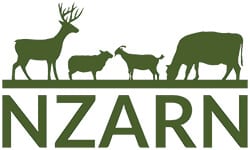Pip scene set this presentation by proposing that we are hit with “data overload/decision paralysis” around what to do with options facing us regarding transition cow management programmes. “Winning” with regard to good outcomes from excellent transition management means limiting the of incidence of metabolic disease to <1%, supporting optimum DMI through understanding the “HOT” concept, delivering ME and MP requirements, managing BCS losses through early lactation to less than 0.6 of 1 BCS, optimising MS production with longer peaks and reduced metabolic stress, better protein yields, and better 6 week in-calf rates.
Pip steps us through a discussion around the role for calcium (Ca) and phosphorus (P) in the pre-calving diet. Recommendations are for 0.4-0.8% Ca in precalving diets, however the relationship between Ca and risk of milk fever is quadratic, with low and high levels of calcium being potentially protective against risk of milk fever. Risk of metabolic diseases increases as level of P in pre-calving diets increase beyond 0.4%, which works against attempts by the cow to acidify blood before calving. Pip reminds us that that an appropriate P content of diet is essential for a range of other functions in the periparturient cow, for example, young growing cattle (in extensively grazed cattle in Australia, particularly), and for rumen microbiome functionality.
P deficient “crawler” cows are discussed, including practical reasons why and how P deficiency occurs on farm. Pasture-fed cows can still be at risk of P deficiency pre-calving due to the standard distribution around the “average” cow regarding what she eats, and what what she is capable of producing from a milk point of view.
Different forms of phosphorus will deliver different digestible P (as a % of total P), within the range of P supplements on the market, and also for P present in different feeds.
Pip explains that binders, synthetic zeolites, in transition diets were initially focused on Ca binding properties, but more recently defined more likely as providing benefits to the transition cow from these products as P binding and less so Ca binding. P binders are influencing FGF23, increasing levels of Vitamin D3 and therefore reducing risk of hypocalcaemia on the day of calving in a mechanism that differs from a negative DCAD in transition diets influencing greater levels of vitamin D3 via PTH.
Inflammatory changes measured as immune activation (Haptoglobin) through calving and the role of these in transition cows is covered by Pip, including the association between immune activation and risk of metabolic disease. The role for dietary manganese (Mn) and risk of milk fever is covered, likely moderated by the role for Mn in optimised osteoclastic activity within the bones.
Q and A facilitated by Pip after the presentation included discussions around approaches to1:1 Ca and P ratios in transition diets, use of Ca supplements before calving, care around use of raw materials / supplements coming on farm (and the need to test these), MS benefits and possible changes in BCS associated with synthetic zeolite products, measuring P status of cows (and discussion around the limitations of blood P testing for assessing flux of P and overall cow wellbeing). Magnesium (Mg) and role for increased Mg in downer cows is discussed (specifically in NZ) possible mechanism via calcitonin, stimulate storage mechanism in bone, storing more Ca than releasing, increased risk of hypocalcaemia.
Pip was born and raised on farm in the pristine far north-west corner of Tasmania – a community centred around grazing dairy businesses. After studying theology… Pip made the move back into dairy business management, technical nutrition and consulting.
He has spent the last 25 years working in both corporate and private company executive roles, providing a core technical focus on the collaboration of animal health and production via nutritional interventions, with a strong linkage to improving environmental and financial sustainability within ruminant facing businesses.
Pip recently joined the technical ruminant team at Feedworks, providing an array of nutrition support services and serving as a professional development educator to the ruminant sector on both sides of the Tasman.
Alongside his corporate responsibilities, Pip has served on the executive of the AARN for 5 years, with a 3 year stint as Vice President and 2 years serving as President. He also provides professional support services via Dairy Australia in the form of facilitating the “Advanced Nutrition In Action (ANIA)” courses across Victoria, South Australia and Tasmania. Pip has been privileged to provide nutrition consulting services to a number of Australasia’s larger corporate dairy businesses to support their pursuit of continuous improvement.
NZARN members a copy of the presentation is available below if you are logged in.
Non-members looking for more information are encouraged to use our ‘contact a nutritionist’ form and ‘member directory’ to find a member who can help them answer their questions.
If you are a Rural Professional interested in joining the NZARN please see our ‘membership’ section.


